Search results for: 'For'
-
 Roman globular bottle
Roman globular bottlePerfectly preserved glass vessel with globular body. Made in the Eastern Mediterranean during late Roman Imperial times.
Price: on request Marc Aurel Denarius, found 1985 in Stonea Grange, Cambridgeshire
Marc Aurel Denarius, found 1985 in Stonea Grange, CambridgeshireNice dark patina. Rome mint, December 1176 - autumn 177 A.D. Aequitas standing to the left with cornucopiae.
Price: on request Greek Guttos with bearded male head
Greek Guttos with bearded male headFrom the Greek colonies of Southern Italia, Magna Graecia. 4th - early 3rd century B.C. Ex German private collection, acquired at Schloss Ricklingen May 1979 auction, Germany.
Price: on request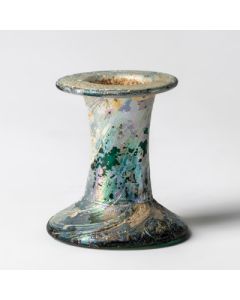 Roman glass
Roman glassBeautifully iridescent turquoise-green glass in a cylindrical shape. From the Roman Imperial period.
€350 Amphora with beautiful marina patina
Amphora with beautiful marina patinaTable amphora, or vessel for transport of particularly precious goods. The beautiful dense marine patina makes this vase a true eye-catcher. From the Austrian collection of Prof. Ritschel, carrier of the Large Cross of Honor of the Austrian Republic and many other prizes and honors.
Price: on request Egyptian New Year flask with ornamentation
Egyptian New Year flask with ornamentationHieroglyphic inscription expressing New Year wishes for Ptah at the beginning of the nile floodings. Important 26th dynasty piece associated with the Egyptian New Year rituals. The object is a fantastic example of the skilled workmanship and artistic quality of faience in ancient Egypt.
Price: on request Glass flask in bowl
Glass flask in bowlThis uncommon glass object from Roman times consists of a household glass flask that has been set in a glass bowl. It is a mystery if it has been made for a practical purpose or if it is a trial piece of a glassblower.
Price: on request Stone Age bow scraper from Egypt
Stone Age bow scraper from EgyptThe Paleolithic tool is of beautiful shape and color. Thebes has been handed down as the place of origin. Including old museum display.
Price: on request Mesopotamian cylinder seal
Mesopotamian cylinder sealMade of beautiful red stone, worked with the drill. From the transitional period between Chalcolithic and Early Bronze Age in Mesopotamia.
Price: on request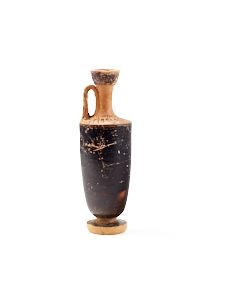 High lekythos found in Athens area
High lekythos found in Athens areaImpressive ancient oil vessel. From an old German collection, acquired in the 1960s at Hermann Zirkel Gallery in Cologne.
Price: on request Etruscan bronze figurine of a woman with patera
Etruscan bronze figurine of a woman with pateraPerfectly preserved, with nice patina. From an old German private collection, acquired 1978 in London at Davies Antiques Gallery.
Price: on request Published Neo-Hellenistic frog lamp from Adler collection
Published Neo-Hellenistic frog lamp from Adler collectionFrom the famous Judge Dr. Steve Adler collection. Exported from Israel with IAA permit Nr. 542792.
Price: on request Roman jug made of aubergine glass
Roman jug made of aubergine glassBeautiful glass with a violet colour. From the Roman Imperial period.
Price: on request Egyptian coffin with lizard
Egyptian coffin with lizardThe small bronze votive box is adorned with a lizard figure on top. The artefct is from the famous collection of Fouad S. Matouk (1902-1978).
Price: on request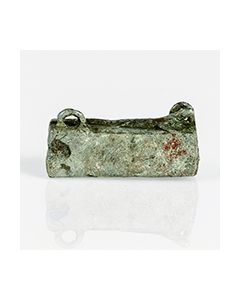 Egyptian votive box with lizard
Egyptian votive box with lizardThe small bronze coffin is adorned with a lizard figure on top. The artefct is from the famous collection of Fouad S. Matouk (1902-1978).
Price: on request Egyptian mummy cartonnage from Thebes
Egyptian mummy cartonnage from ThebesChest and leg piece of a mummy cartonnage from the ptolemaic period. Covered with polychrome paintings giving an interesting insight into ancient Egyptian funerary rituals.
Price: on request Dolphin brooch from Roman Britain
Dolphin brooch from Roman BritainThe so-called dolphin brooch is very British. This specimen was probably made by the Celtic Corieltauvi tribe, shortly after the arrival of the Romans in the middle of the 1st century. Published in two works by Richard Hattatt.
Price: on request Egyptian scarab with cross design
Egyptian scarab with cross designAmulet seal with complex design of crosses on the underside. Second Intermediate Period of ancient Egypt.
Price: on request Scarab with cross design
Scarab with cross designAmulet seal with complex design of crosses on the underside. Second Intermediate Period of ancient Egypt.
Price: on request Egyptian scarab with interesting stamp design
Egyptian scarab with interesting stamp designAmulet seal with a complex knot design on the underside, possibly symbolizing the unity of Egypt. Second Intermediate Period of ancient Egypt.
Price: on request Egyptian scarab with knot design
Egyptian scarab with knot designAmulet seal with a complex knot design on the underside, possibly symbolizing the unity of Egypt. Second Intermediate Period of ancient Egypt.
Price: on request Egyptian scarab
Egyptian scarabAmulet seal in the shape of a scarab with schematic top side and braided tape on the underside. Second Intermediate Period of ancient Egypt.
Price: on request Egyptian scarab with spiral design
Egyptian scarab with spiral designAmulet seal in the shape of a scarab with schematic top side. Second Intermediate Period of ancient Egypt.
Price: on request Egyptian scarab with tree of life
Egyptian scarab with tree of lifeAmulet seal with figural scene on the underside, two standing figures next to tree of life. Third Intermediate Period of ancient Egypt.
Price: on request Egyptian scarab
Egyptian scarabAmulet seal with pseudo hieroglyphs on the underside. Late or post Ramesside period.
Price: on request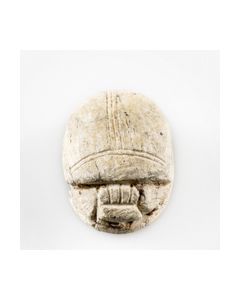 Egyptian scarab with tree of life
Egyptian scarab with tree of lifeAmulet seal with tree of life on the underside. Third Intermediate Period of ancient Egypt.
Price: on request Egyptian scarab with pharao
Egyptian scarab with pharaoAmulet seal with pharao and servant on the underside. Third Intermediate Period of ancient Egypt.
Price: on request Pyxis from museum collection - found in Naples area
Pyxis from museum collection - found in Naples areaLovely small vessel with original lid. From an old German collection, acquired in the 1960s at Hermann Zirkel Gallery in Cologne.
Price: on request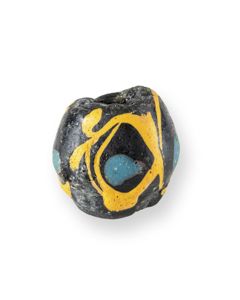 Glass bead with polychrome decoration
Glass bead with polychrome decorationLarge bead made of opaque dark blue glass decorated with yellow lines and light blue eyes.
Price: on request Roman oil lamp with personification of Africa
Roman oil lamp with personification of AfricaProduced in the workshop of Marcus Novius Iustus between 120 and 180 A.D. The province Africa is shown as a woman with exposed breast wearing a Pharaonic headdress between elephant tusks. From an old German collection, acquired before 1979 at Galerie fuer antike Kunst Karl Heinz Zuehlsdorf, Cologne.
Price: on request Egyptian button seal
Egyptian button sealAmulet seal as a good luck charm with a protective function. Second Intermediate Period of ancient Egypt.
Price: on request Neolithic stone tool from Egypt
Neolithic stone tool from EgyptThe Stone Age weapon's point or knife blade is well crafted, with finely serrated edge. From a 100 year old museum collection.
Price: on request Necklace of Egyptian mosaic glass beads
Necklace of Egyptian mosaic glass beadsModernly threaded necklace of ancient beads made of beautiful mosaic glass and sheet gold. The mosaic originated in a workshop in Roman Egypt. Ex Christie's.
Price: on request Large ceremonial knife of the Sican culture
Large ceremonial knife of the Sican cultureThe so-called Tumi was a weapon to cut the throats of humans and animals in ritual sacrifices. The knife certainly fulfilled an additional representative function in the afterlife. From the period of the Sican's cultural florescence during the 10th to 12th centuries AD.
Price: on request Decorative disc of the Amlash culture
Decorative disc of the Amlash cultureGold sheet artfully crafted in the repoussé technique, with a relief depicting reclining ibexes. Possibly the decoration of a sword pommel. Exhibited and published by the Art Institute of Chicago in the 1970s.
Price: on request Corinthian aryballos with large bird
Corinthian aryballos with large birdFrom an old German collection, acquired 1978 at Davies Antiques, London. Corinthian, 6th century B. C.
Price: on request

